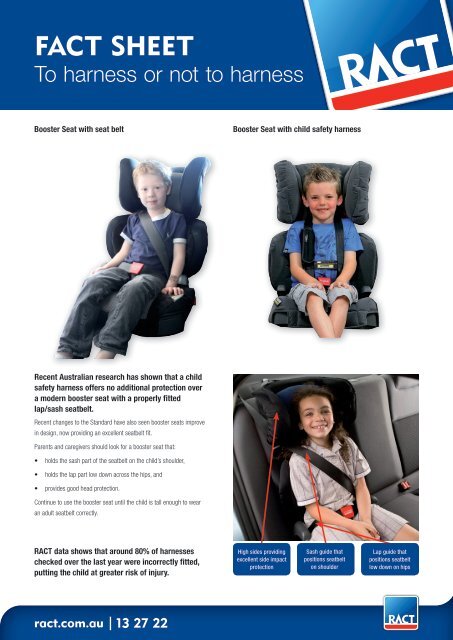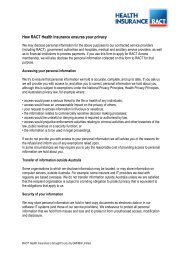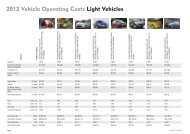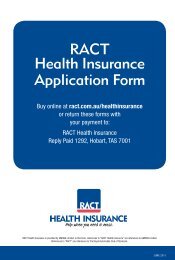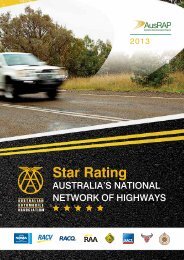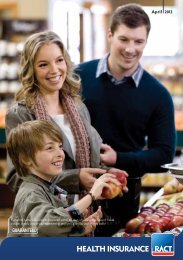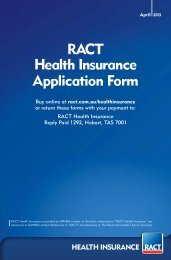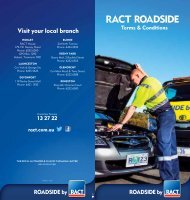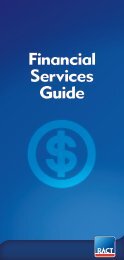Information on harnesses - RACT
Information on harnesses - RACT
Information on harnesses - RACT
Create successful ePaper yourself
Turn your PDF publications into a flip-book with our unique Google optimized e-Paper software.
FACT SHEET<br />
To harness or not to harness<br />
Booster Seat with seat belt<br />
Booster Seat with child safety harness<br />
Recent Australian research has shown that a child<br />
safety harness offers no additi<strong>on</strong>al protecti<strong>on</strong> over<br />
a modern booster seat with a properly fitted<br />
lap/sash seatbelt.<br />
Recent changes to the Standard have also seen booster seats improve<br />
in design, now providing an excellent seatbelt fit.<br />
Parents and caregivers should look for a booster seat that:<br />
• holds the sash part of the seatbelt <strong>on</strong> the child’s shoulder,<br />
• holds the lap part low down across the hips, and<br />
• provides good head protecti<strong>on</strong>.<br />
C<strong>on</strong>tinue to use the booster seat until the child is tall enough to wear<br />
an adult seatbelt correctly.<br />
<strong>RACT</strong> data shows that around 80% of <strong>harnesses</strong><br />
checked over the last year were incorrectly fitted,<br />
putting the child at greater risk of injury.<br />
High sides providing<br />
excellent side impact<br />
protecti<strong>on</strong><br />
Sash guide that<br />
positi<strong>on</strong>s seatbelt<br />
<strong>on</strong> shoulder<br />
Lap guide that<br />
positi<strong>on</strong>s seatbelt<br />
low down <strong>on</strong> hips<br />
| 13 27 22
FACT SHEET To harness or not to harness<br />
However, a child safety harness may still be recommended when:<br />
• there is <strong>on</strong>ly a lap belt available, or<br />
• extra support is required for a child with disabilities.<br />
Note: If your vehicle has a lap-<strong>on</strong>ly seatbelt it may be possible to replace it<br />
with a lap-sash seatbelt rather than use a harness. This would make it safer<br />
for everybody that sits there, including adults.<br />
What advice do you have if I do need to use a harness<br />
If a harness is required, it is recommended to <strong>on</strong>ly use it <strong>on</strong> a booster seat<br />
that features an antisubmarining buckle, such as the <strong>on</strong>e below. The antisubmarining<br />
clip holds the lap part of the belt down low across the hips and<br />
doesn’t allow the belt to be pulled up over the abdomen.<br />
If you must use a child safety harness ensure that:<br />
• the harness is compatible for use with the booster<br />
• it is <strong>on</strong>ly used <strong>on</strong> a booster with an antisubmarining clip<br />
• it is fitted in accordance with the manufacturer’s instructi<strong>on</strong>s<br />
• the lap part of the seatbelt is low and firm across the hips<br />
• the shoulder straps of the harness are not overtightened<br />
• the harness is fitted or checked by a restraint fitter to ensure that it is<br />
fitted and adjusted correctly<br />
• the harness is checked for good fit each time that it is used.<br />
Shoulder straps are<br />
not overtightened<br />
Lap part is low and<br />
firm across hips<br />
Anti-submarining<br />
buckle used<br />
For more informati<strong>on</strong> <strong>on</strong> <strong>RACT</strong> Child Restraints c<strong>on</strong>tact <strong>RACT</strong> <strong>on</strong> 132 722,<br />
visit www.ract.com.au or email educati<strong>on</strong>@ract.com.au<br />
| 13 27 22


